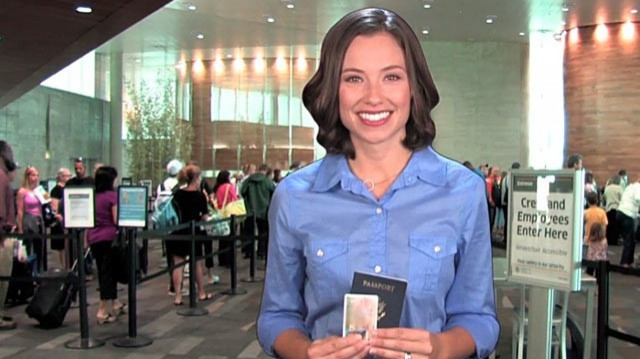Beyond Tupac: New Airport Holograms Assist Passengers

When Tupac dazzled audiences at the Coachella music festival earlier this year, it heralded the mainstream arrival of the hologram. There was talk of a touring hologram Elvis and a dancing Marilyn Monroe, but few realized they'd soon interact with holograms on a more personal level at a place close to home: the local airport.
Introducing Paige and Carla. These virtual assistants are the first in a series of hologram personalities popping up at airports across the United States. Paige made her debut in April at Washington Dulles, greeting and guiding international arrivals through customs as part of a summer-long pilot project. Carla, meanwhile, joined the staff at Boston's Logan International Airport last month in a different role, offering tips for getting through the security checkpoint in two languages: English and Spanish.
Ed Freni, director of aviation for the Massachusetts Port Authority, or Massport, said good security means good customer service. He hopes Carla can improve both.
This new virtual greeter gives us an opportunity to collaborate with the TSA on a more efficient security checkpoint by educating passengers ahead of time on the do's and the dont's of security screening, he said. Our best asset in making the security screening process move along faster is an informed and prepared customer.
And who better, technocrats argue, than a virtual assistant to prepare customers.
Freni dispelled rumors that the avatar would replace any existing staff members, saying it simply grabs more attention than some of the signs and videos already in place.
Both Carla and Paige were designed by Tensator, a global leader of queue management solutions. Next up is Ava, developed by Florida-based aviation marketing company Airus Media.
Ava will make her debut in July at three New York City area airports -- LaGuardia, JFK and Newark Liberty. The smiley hologram will greet an estimated 31 million passengers that fly in and out of the three airports this summer and is expected to remain beyond the six-month demo period.
To create the avatars, the videotaped image of a real-life spokesmodel is projected onto the back of a quarter-inch-thick Plexiglas cutout, creating a moving color image in the front. Each avatar is then customized for the airport where it is installed. While neither Tensator's nor Airus Media's avatars function on call and response cues, developers say new models that can answer travelers' questions may arrive by the year's end.
The technology does not come cheap. The Ava model, for example, will reportedly cost the Port Authority of New York and New Jersey $180,000 for the six-month demo period and $250,000 each if purchased outright.
Costly as the technology may be, it has proved successful overseas.
Airports in the UK, Germany, France and the United Arab Emirates introduced hologram-like installations to help passengers last year, and Future Travel Experience reports that incorrectly packed bags at London Luton, for example, have been reduced by 5 percent since the airport introduced avatars Holly and Graham at security checkpoints.
The avatars help reduce costs in other ways too. They work 24-hour shifts without overtime pay and don't complain, need lunch or take bathroom breaks.
© Copyright IBTimes 2024. All rights reserved.





















